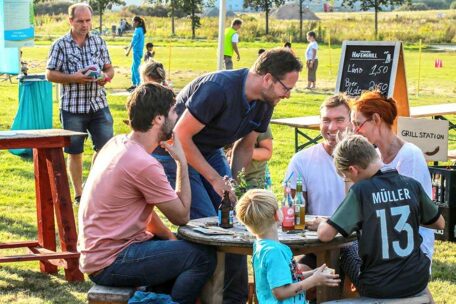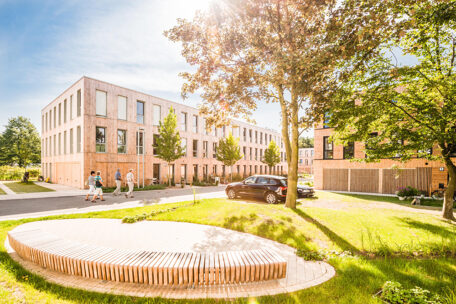Housing
IBA Hamburg aims to develop vibrant and sustainable neighbourhoods with a balanced mix of subsidised rental housing, affordable privately financed rental housing and owner-occupied housing. This so-called one-third mix has already proven to be an effective basic tool for developing sustainable neighbourhoods. Another goal of IBA Hamburg is to create housing of high quality in terms of urban planning and building construction. The aim is to plan Hamburg's neighbourhoods in a future-proof manner and to ensure the city's high quality of life for future generations.
Easily accessible public transport, suitable infrastructure that is accessible to all, short distances to relevant locations, measures to adapt to climate change, careful treatment of nature and promotion of biodiversity, and multifunctional green spaces are just a few examples of the holistic planning of the neighbourhoods.
The human right
to housing is enshrined in many laws in Germany.
With around 140,000 rental apartments,
he SAGA Group is the largest housing company in the city of Hamburg.
13,74 Euro
was the average rent per square metre per month in Hamburg in 2024 (Statista 2025).
‘At IBA Hamburg, we are developing 40 per cent of the future urban housing potential of the Free and Hanseatic City of Hamburg with innovative, sustainable neighbourhoods that offer affordable living space and a high quality of life.’
Kay Gätgens
Managing Director IBA Hamburg
Diversity of building types
The plan is to create suitable living space for almost all needs and requirements. One key to promoting the liveliest possible neighbourhood is the realisation of different building typologies, i.e. multi-family dwellings in multi-storey buildings, terraced houses and so-called townhouses.
IBA Hamburg pursues high design standards that incorporate floor plans, façades and the transitions from private to public spaces.
In the IBA Hamburg neighbourhoods, there is always a mix of commercial or social infrastructure on the lower floors and residential space on the upper floors.
Accessibility and inclusion
In neighbourhoods, everyone should be able to participate in social life on an equal footing and without barriers. The more barrier-free and accessible homes there are in a neighbourhood, the better participation will be. In addition, an inclusive neighbourhood is characterised by accessible public spaces and mobility options. Furthermore, other private areas, such as social facilities, neighbourhood meeting places, sports facilities and everyday amenities and services, should be accessible to all.
Housing options for older people
Older people should be able to live in their own flat or shared accommodation for as long as possible and, if necessary, have access to a contact point or emergency service within their neighbourhood. Possible models include dementia-friendly shared accommodation, assisted living in shared accommodation, residential and care facilities with care on demand, day care in combination with various forms of accommodation, and housing projects based on the so-called ‘Bielefeld model’.
Building cooperatives
In the IBA Hamburg neighbourhoods, up to 20 percent of the land is allocated to building cooperatives. A building cooperative is defined as a group of at least three households. They create living space together in various forms of ownership, i.e. under hereditary building rights, as a condominium owners' association or under the umbrella of a large cooperative. This is often accompanied by a special, individual building and living concept. To apply as a building cooperative, you must be registered with the City of Hamburg's Agency for Building Cooperatives.
Innovative types of housing and construction methods
Are you currently interested in buying or renting?
Multi-family and terraced houses are being built and marketed in individual construction phases by investors or housing associations. IBA Hamburg does not arrange flats for individual tenants or buyers and does not maintain waiting lists.
Offers for investors and housing associations known to us can be found online at: iba-hamburg.de/bauen/wohnen (German)
Sign up for our newsletter (in German) to receive information about current project developments in the future.
Are you a full-time investor or project developer?
IBA Hamburg publishes property tenders on its German website www.iba-hamburg.de/bauen as soon as marketing for individual construction phases begins.
For enquiries about properties and tenders from IBA Hamburg, please contact , Sales Project Coordinator.
As a professional investor, you are welcome to join the IBA Hamburg mailing list for investors.

